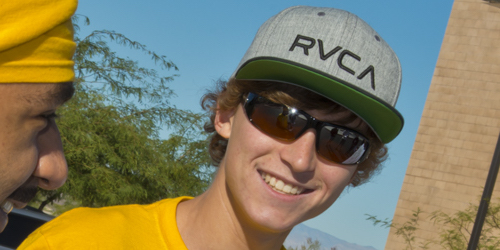By Jess Kusak
The make it or break it point for academic success comes early in a student’s educational experience. NSC’s Project Crossroads targets middle school students for this very reason. Project Crossroads specifically reaches out to this age group because the incidence of drop-out rates increases during the middle school and high school years.
Project Crossroads is a collaborative effort between Nevada State College and Area 2 of the Clark County School District (CCSD), helping at-risk 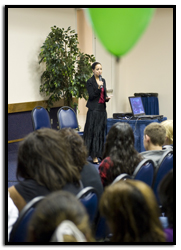 middle school students. Through this program, students from 14 middle schools in the eastern and southeastern region of the Las Vegas Valley are provided guidance and mentorship, which encourages them to stay in school and ultimately continue on to high school and a higher education.
middle school students. Through this program, students from 14 middle schools in the eastern and southeastern region of the Las Vegas Valley are provided guidance and mentorship, which encourages them to stay in school and ultimately continue on to high school and a higher education.
Through the generous support of Bill Wortman, Principal of Cannery Casino Resorts and NSC Foundation Board of Trustees Member, the Nevada Public Education Foundation Nevada ACCESS Grant Program, and additional support from USA Funds, Project Crossroads is brought to fruition.
During the kick-off Project Crossroads event of the year, college faculty, staff and over 30 NSC student mentors led a series of break-out sessions discussing everything from setting goals, gaining self-awareness, exploring different educational and career options and becoming involved in community volunteerism and school activities.
This year, the program welcomed special guest speaker Maria Silva, KVBC Channel 3 news anchor. Ms. Silva imparted her own journey of educational triumphs and hardships as being a first-generation, low-income college student in Nevada. NSC President Dr. Fred Maryanski also addressed the students, sharing with them his story of reaching success as being the first person from his family to graduate from high school and pursue a higher education. Each of their heartfelt testimonials resonated with the students, inspiring them to strive for possibilities they perhaps had not considered before.
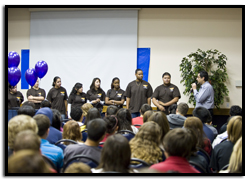 At the finale of the event, President Maryanski and Ms. Silva announced to the students they would each receive an NSC Promise certificate, which is good for a $500 scholarship toward an education at NSC. When the students complete high school and successfully meet the admissions standards for the college, they can utilize the Promise incentive for their first NSC semester.
At the finale of the event, President Maryanski and Ms. Silva announced to the students they would each receive an NSC Promise certificate, which is good for a $500 scholarship toward an education at NSC. When the students complete high school and successfully meet the admissions standards for the college, they can utilize the Promise incentive for their first NSC semester.
Gregory Ross, and NSC sophomore Business major and Project Crossroads mentor sees a lot of untapped potential in the children he works with through the program. They have many talents and interests, but don’t know how to cultivate them. I encourage them to challenge themselves and broaden their horizons by trying out new learning activities and experiences.
In addition to unrealized potential, many of the children in Project Crossroads are disengaged and bored in their learning environments. Mentors and facilitators from Project Crossroads help bridge that gap and get the children engaged in school again so they can perform to their full potential, catch up on academic credits and successfully move on to high school and college.
Project Crossroads meets four times throughout the academic year, each time bringing the students into a new non-traditional learning environment characterized by teamwork, cooperation and high expectations. For one of the upcoming Project Crossroads events for example, students will come 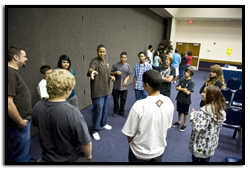 to the NSC campus to experience a college visit, as well as lectures and presentations by college professors. Experiences such as these help the students develop a sense of motivation, self-esteem and resiliency, which will help them thrive in a pressure filled collegiate setting. Additionally, experiencing a day in the life of a typical NSC student allows them to see themselves as college students, realizing that a higher education is an attainable goal.
to the NSC campus to experience a college visit, as well as lectures and presentations by college professors. Experiences such as these help the students develop a sense of motivation, self-esteem and resiliency, which will help them thrive in a pressure filled collegiate setting. Additionally, experiencing a day in the life of a typical NSC student allows them to see themselves as college students, realizing that a higher education is an attainable goal.
To bolster the quarterly Project Crossroads gatherings, the NSC student mentors will go to each of the participating schools once per week for two hours. Project Crossroads facilitators have found it is important to follow-up with the children, so they have continual mentoring throughout the school year. Follow-up mentoring was actually a component for a pilot program for last year’s Project Crossroads endeavors. Each week, one NSC student mentor met with Crossroads students from Burkholder middle school, both individually and in groups, to monitor their progress and guide them. The outcome of the pilot yielded remarkable results. Of the 15 students who began the program in the fall, 14 completed the program and successfully transitioned from middle school into high school.
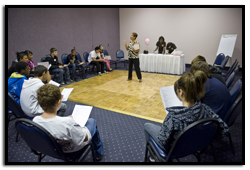 Project Crossroads participants have much to gain from this innovative program, but NSC student mentors have also grown from their experiences with the mentees. Student mentors are able to realize the reward that is not monetary and see the positive impact their efforts can have on another person’s life.
Project Crossroads participants have much to gain from this innovative program, but NSC student mentors have also grown from their experiences with the mentees. Student mentors are able to realize the reward that is not monetary and see the positive impact their efforts can have on another person’s life.
In addition to becoming even more intensely engaged in their own success, the student mentors have cultivated a sense of active volunteerism and community engagement beyond their academic pursuits. As Dr. Maryanski shared, NSC is an institution of higher learning that is actively interacting with the community. There is much we can learn from each other and through programs such as Project Crossroads, we improve everyone’s quality of life.
Project Crossroads Starts the Year Off with Mentoring and Scholarship Opportunities for At-Risk Middle School Students
